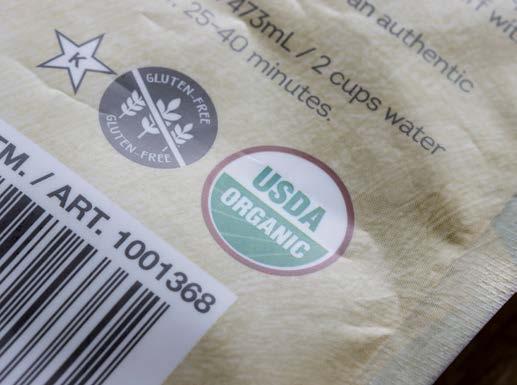
5 minute read
Crop Insurance News
NOW IS THE TIME TO SIGN UP FOR HAIL INSURANCE!
What used to be considered a fairly rare event seems far more commonplace now. Hail is a separate policy from your multi-peril crop insurance coverage. Federal crop insurance covers hail damage as it relates to yield reduction, but producers can also purchase separate hail coverage for their crops from the same companies that offer federal crop insurance. As an added bonus, your hail policy can provide coverage for fire, lightning, vandalism/malicious mischief and transit to the first place of storage. Hail insurance is based on the percent of damage received at a particular growth stage, which allows insurance companies to perform adjustments and pay indemnities during a growing season, without having to wait until harvest. Rates and coverage vary by crop and county. Keep in mind, hail insurance must be purchased before damage occurs. Below are some other important items of note regarding hail coverage. • Most hail insurance covers other perils above and beyond hail damage. Policies can also cover fire, vandalism and malicious mischief, transit to the first point of storage, and stored grain coverage if you happen to have bin(s) at home. • Hail coverage is available on most any crop; if you don’t have a Federal crop insurance option, it can generally be covered for hail. • A customer is able to carry a Federal MPCI policy as well as a hail policy, and collect on both in the event of a loss.
• Hail coverage is based on a dollar amount of coverage per acre, with premium generally quoted per $100 of coverage. For example, if someone wanted to cover their corn at $700 per acre, and the premium was 60 cents per $100 of coverage, their premium for corn would be $4.20 per acre. • One benefit to hail insurance over MPCI is that you can insure up to the total expected value of the crop, whereas on MPCI you’re limited to 85%.
• Hail coverage generally has many different endorsements available, including quality endorsements on crops intended for fresh market, canning reject endorsements, etc. To learn more on how a hail policy works or what options are available and covered with a hail policy, contact your GreenStone crop insurance specialist today to review your options. Most claims will not be paid until the review is completed. The earlier the process begins, the earlier a claim can be paid. For more details, please contact your local GreenStone crop insurance specialist. ■
EARLY/FINAL PLANT DATES
Early and final plant dates vary by crop, county and state. Coverage levels can be reduced if a crop is planted too early or too late. Please check with your crop insurance specialist or actuarial documents for specific details and dates for your county if you are unsure about which dates apply to your policy. ■
2022 FALL WHEAT & FORAGE CLAIMS
Appraisals are required when a customer plans to do something with the crop other than harvest in the normal manner. If you do not plan to take your wheat/ forage crop to harvest, we must appraise the acres prior to destruction. ■
ACREAGE REPORTS
The earlier we get started on reporting your planted crop acres, the earlier we can process your reports and return for your review. It is the customer’s responsibility to report the crop that was planted in each section, the planting date and your percent share of that crop. Reporting your crop accurately and double checking everything on the Schedule of Insurance is very important. Corrections or changes cannot be made after the July 15th reporting deadline. You do not need to report to FSA before reporting your planted acres to your crop insurance specialist. If you use precision planting technology, we can save you a lot of time reporting acres. Contact your local GreenStone crop insurance team if you have any questions or would like assistance. ■
1ST CROP/2ND CROP
If you are planning on possibly removing a first crop to plant a second, make sure you contact your crop insurance agent before doing so. You could potentially be eligible for a claim, but you may forfeit that eligibility if you act before contacting your agent to discuss your options! ■
ENTERPRISE UNITS STRUCTURE
The added subsidy on the enterprise unit structure makes it an affordable option for many producers. The downside is, if you don’t end up planting the required acreage, your policy can revert back to a basic unit structure, and your premium could increase substantially. There are two requirements to qualify for enterprise units: You must farm in two or more separate sections. AND At least 20 acres, or 20% of your individual crop acreage, whichever is less, must be planted in that second section. Adverse spring weather has the potential to cause prevented planting which could take some producers out of enterprise unit eligibility. Make sure to contact your crop insurance agent if you anticipate any issues with meeting the enterprise unit requirements. ■
CROP INSURANCE ALERTS!
Crop Insurance Alert postcards and emails will be sent on an “as needed” basis to customers. The goal is to communicate any vital information that we receive and feel necessary to pass along to you. When you receive one, please pay attention to its message. That way, any required action on your part can be completed on a timely basis. ■ If weather conditions prevent you from planting or you need to replant a crop, you may qualify for a claim. File a claim with your crop insurance specialist before replanting. DO NOT replant until you have received approval to do so, or you may not receive an indemnity. If you have a prevent plant situation, a claim must be filed within 72 hours after the end of the late planting period, which varies by crop. (There is a minimum requirement of 20% of the unit or 20 acres for both replant and prevent plant claims, whichever is less.) Some important changes were made for the current crop year in regards to both Replant and Prevent Plant rules. Depending on the timing of the replant period, weather and field conditions, you could be required to replant. Please contact your crop insurance specialist for the most current rules and guidelines. ■
As a reminder, RMA now requires all insured organic certified producers to provide a copy of their organic crop plan and organic certificate to their agent before the acreage reporting date. ■
Crop Insurance Alert Notice!

PREVENTED PLANT OR REPLANT RULES HAVE CHANGED
ORGANIC CROPS









